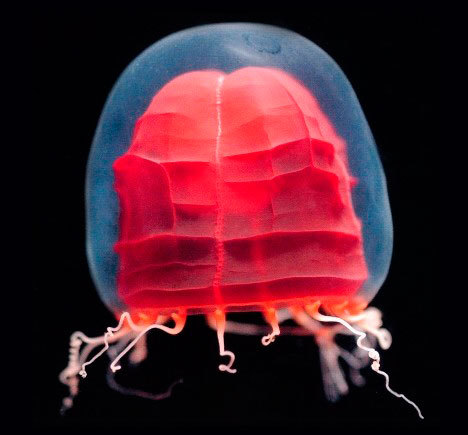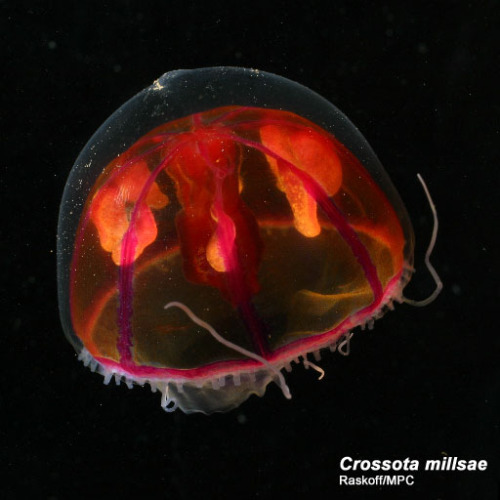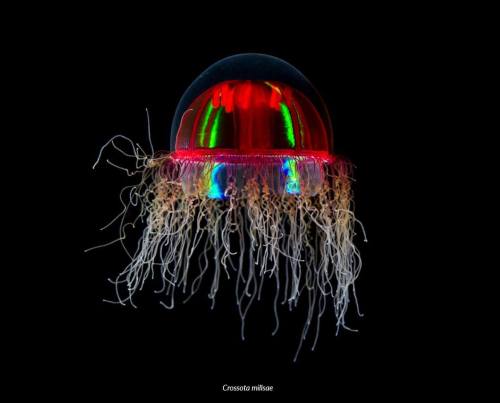Experience Tumblr like never before
Cnidaria - Blog Posts


Helmet Jelly
Periphylla periphylla
The Helmet Jelly can be found at all depths of the ocean. This vibrant and strange jellyfish tends to proliferate in Norwegian fjords. They are one of the dominant predators in these isolated ecosystems.
Photos
http://www.seawater.no/fauna/cnidaria/periphylla.html
https://www.bigfishexpeditions.com/2019/01/24/norway-deepwater-shark-diving-2018/helmet-jelly/


Lav Polyp
leuckartiara octona
The Lav Polypo is a jelly that comes in a variety of colors and shapes; it dwells about 200m in the deep ocean. The red mass inside its translucent bell is the jelly’s reproductive organs. Furthermore, it uses its dull, yellow tentacles can catch unsuspecting prey.
Photo credit: https://www.pinterest.com/pin/65935582019848580/
https://www.petjellyfish.co.uk/shop/live-jellyfish/leuckartiara-octona


Mid-water Arctic Hydrozoan
Botrynema brucei
The Mid-water Arctic Hydrozoan is a mini-jelly that is transparent with hints of blue. It thrives in freezing cold temperatures and drifts aimlessly in the Artic Ocean. Moreover, it is only 3 cm in size and floats between 900m to 2,600m.
Photo credit: https://en.wikipedia.org/wiki/Botrynema_brucei
http://www.arcodiv.org/watercolumn/cnidarian/Botrynema_brucei.html


Red Paper Lantern Medusa
Pandea rubra
The Red Paper Lantern resembles a floating, Japanese paper lantern in the deep sea. It has the ability to crumple and wrinkle its bright, red bell, and it is located at depths between 550m to 1200m. It has also been nicknamed the “origami jelly.”
Photo credit: https://commons.wikimedia.org/wiki/Category:Pandea_rubra
http://www.thegorgeousdaily.com/pandea-rubra/


Psychedelic Medusa
Crossota millsae
The Psychedelic Medusa is a deep-sea hydrozoan that is abundant in the North Pacific. The mini-jelly is found at depths between 1000m to 3800m, and are often observed drifting near the ocean floor. It also has an eccentric reproduction behavior uncommon in cnidarians. The females display viviparity, and carry the babies in her bell until they are ready to hatch.
Photo credit: http://www.arcodiv.org/watercolumn/cnidarian/Crossota_millsae.html
https://twitter.com/spothvegr/status/1030177493075079169


Atolla Jelly
Atolla wyvillei
The Atolla Jelly is a fiery, red jellyfish that has an extraordinary display of bioluminescence. When the jelly is attacked, it uses bioluminescence to produce thousands of vibrant, blue flashes; the blue flashes act as an alarm, which draws in bigger predators and warns prey. The jelly can be found at depths between 600 m to 1500m, and it also has a long hypertrophied tentacle that aids in reproduction.
Photo credit: https://en.wikipedia.org/wiki/Atolla_jellyfish
https://en.wikipedia.org/wiki/Atolla_jellyfish


Giant Bell Jelly
Scrippsia pacifica
The Giant Belly Jelly has 256 tentacles attached to a gelatinous bell-shaped base. Like most cnidarians, the Giant Belly Jelly uses specialized stinging cells called nematocysts to catch its prey. When fish and other prey swim into its tentacles, the sensory projection on the cnidocyte (cell that holds the nematocysts) is activated. Then the nematocysts and barb are released, hitting the vulnerable prey and releasing a toxin into the prey’s body. The Giant Bell Jelly is found at 400 m in the ocean. It is related to the jellyfish, but it is categorized as a Hydrozoa (similar to the Portuguese- man-o-war)
https://vimeo.com/42551565
Photo Credit: https://www.pinterest.cl/pin/467107792572034837/
https://courses.lumenlearning.com/ivytech-bio1-1/chapter/phylum-cnidaria/